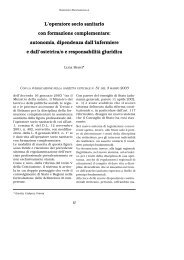Esposizione professionale a chemioterapici antiblastici - Bibliomed
Esposizione professionale a chemioterapici antiblastici - Bibliomed
Esposizione professionale a chemioterapici antiblastici - Bibliomed
Create successful ePaper yourself
Turn your PDF publications into a flip-book with our unique Google optimized e-Paper software.
aumentati, mentre il testosterone rimane a livelli normali. Alcuni autori riportano una<br />
diminuzione della libido nel 70% dei pazienti sottoposti a chemioterapia e il 40% mantiene il<br />
disturbo anche dopo la sospensione della terapia; mentre l’impotenza sembra essere un sintomo<br />
transitorio (19, 21, 22).<br />
Tra i vari farmaci impiegati è la ciclofosfamide quella che sembra avere gli effetti maggiori<br />
sulla funzione testicolare con produzione di azoospermia persistente; Kreuser in un lavoro del<br />
1988 riportava nel follow -up a 11 anni azoospermia nel 100% dei casi trattati con COOP<br />
(ciclofosfamide, vinvristina, procarbazina, prednisone) (23).<br />
Schemi terapeutic i con ABVD (adriamicina, bleomicina, vinblastina, decarbazina)<br />
producono oligozoospermia e azoospermia con recessione completa dopo 1 anno dalla fine del<br />
trattamento.<br />
Bibliografia<br />
1. Mastroianni L, Paulsen CA (Ed.). Aging, reproduction, and the climateric . New York and London:<br />
Plenum Press; 1986.<br />
2. Metz CB, Monroy A (Ed.). Biology of ferilization . Orlando: Accademic Press; 1985.<br />
3. Lippes J, Enders RG, Pragay DA, Bartholomew WR. The collection and analysis of human<br />
fallopian tube fluid. Contraception 1982; 5(2):85-103.<br />
4. Diaz S, Ortiz ME, Croxatto HB. Studies on the duration of ovum transport by the human oviduct.<br />
The time interval between the luteinizing hormone peak and recovery of ova by transcervical<br />
flushing of’ the uterus in normal women. Am J Obstet Gynecol 1980;137:116.<br />
5. Coutinho EM, Mala HS. The contractile response of the human uterus, fallopian tubes and ovary to<br />
prostaglandins in vivo. Fertil Steril 1971;22:539-43.<br />
6. Deiìnker HW. Basic aspects of ova implantation. Obstet Gynecol Ann 1983;12:15 -42.<br />
7. Glasser SR. Current concepts of implantation and decidualization. In: Hoszar C (Ed). The<br />
physiology and biochemistry of the uterus in pregnancy and labor . Boca Raton, Florida; 1986.<br />
8. Mastroianni L, Biggers J (Ed.). Fertilization and embryonic development in vitro. New York:<br />
Plenum Press; 1982.<br />
9. Mann T, Lutwak-Mann C. Male reproductive function and semen . New York: Springer-Verlag;<br />
1981.<br />
10. Haas GG, Beer AE. Immunologic influences on reproductive biology: Sperm-gametogenesis and<br />
maturation in the male and female genital tracts. Fertil Steril 1986; 46:753-66.<br />
11. Bardin CW, Sherins RJ (Ed.). The cell biology of the testis. Ann NY Acad Sci 1982; 383.<br />
12. Yen SSC. The human menstrual cycle. In: Yen SSC, Jaffe RB (Ed.). Reproductive endocrinology .<br />
Philadelphia: Saunders; 1986. p. 200 -36.<br />
13. Harper NJK. Gamete and zygote transport. In: Knobil E, Neill J (Ed.). The physiology of<br />
reproduction . New York: Raven Press; 1988. p. 103-34.<br />
14. Candell FR, Swerdeloff RS. Role of temperature in regulation of spermatogenesis and the use of<br />
heating as a method of contraception. Fertil Steril 1988;49:1 -23.<br />
15. Russell LD. Spermiation – the sperm release process: ultrastructural observations and unresolved<br />
problems. In: Van Blerkom J, Motta PM (Ed.). Ultrastructure of reproduction . The Hague:<br />
Martinus Nijhoff; 1984. p. 46-66.<br />
16. Romagnolo C, Marchesini D, Maggino T. Antiblastic chemoterapy and reproductive life. Clin Exp<br />
Obstet Gynecol 1988;15:38-46.<br />
43



